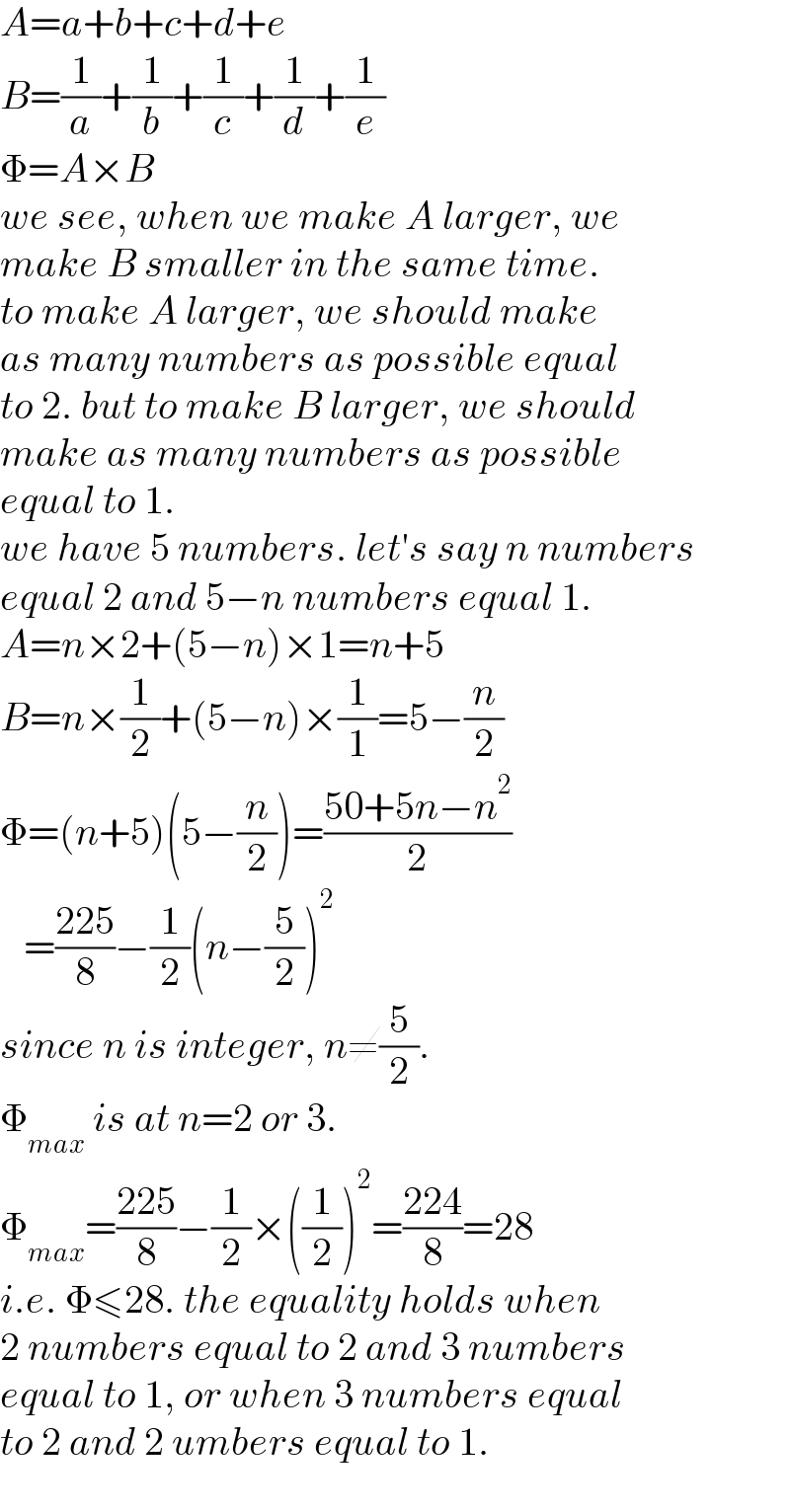
Question Number 178818 by Shrinava last updated on 21/Oct/22
![If a,b,c,d∈[1,2] then prove that: (a + b + c + d + e)((1/a) + (1/b) + (1/c) + (1/d) + (1/e)) ≤ 28 When equality holds?](Q178818.png)
$$\mathrm{If}\:\:\:\mathrm{a},\mathrm{b},\mathrm{c},\mathrm{d}\in\left[\mathrm{1},\mathrm{2}\right]\:\:\:\mathrm{then}\:\mathrm{prove}\:\mathrm{that}: \\ $$$$\left(\mathrm{a}\:+\:\mathrm{b}\:+\:\mathrm{c}\:+\:\mathrm{d}\:+\:\mathrm{e}\right)\left(\frac{\mathrm{1}}{\mathrm{a}}\:+\:\frac{\mathrm{1}}{\mathrm{b}}\:+\:\frac{\mathrm{1}}{\mathrm{c}}\:+\:\frac{\mathrm{1}}{\mathrm{d}}\:+\:\frac{\mathrm{1}}{\mathrm{e}}\right)\:\leqslant\:\mathrm{28} \\ $$$$\mathrm{When}\:\mathrm{equality}\:\mathrm{holds}? \\ $$
Answered by mr W last updated on 22/Oct/22

$${A}={a}+{b}+{c}+{d}+{e} \\ $$$${B}=\frac{\mathrm{1}}{{a}}+\frac{\mathrm{1}}{{b}}+\frac{\mathrm{1}}{{c}}+\frac{\mathrm{1}}{{d}}+\frac{\mathrm{1}}{{e}} \\ $$$$\Phi={A}×{B} \\ $$$${we}\:{see},\:{when}\:{we}\:{make}\:{A}\:{larger},\:{we} \\ $$$${make}\:{B}\:{smaller}\:{in}\:{the}\:{same}\:{time}. \\ $$$${to}\:{make}\:{A}\:{larger},\:{we}\:{should}\:{make} \\ $$$${as}\:{many}\:{numbers}\:{as}\:{possible}\:{equal} \\ $$$${to}\:\mathrm{2}.\:{but}\:{to}\:{make}\:{B}\:{larger},\:{we}\:{should} \\ $$$${make}\:{as}\:{many}\:{numbers}\:{as}\:{possible}\: \\ $$$${equal}\:{to}\:\mathrm{1}. \\ $$$${we}\:{have}\:\mathrm{5}\:{numbers}.\:{let}'{s}\:{say}\:{n}\:{numbers} \\ $$$${equal}\:\mathrm{2}\:{and}\:\mathrm{5}−{n}\:{numbers}\:{equal}\:\mathrm{1}. \\ $$$${A}={n}×\mathrm{2}+\left(\mathrm{5}−{n}\right)×\mathrm{1}={n}+\mathrm{5} \\ $$$${B}={n}×\frac{\mathrm{1}}{\mathrm{2}}+\left(\mathrm{5}−{n}\right)×\frac{\mathrm{1}}{\mathrm{1}}=\mathrm{5}−\frac{{n}}{\mathrm{2}} \\ $$$$\Phi=\left({n}+\mathrm{5}\right)\left(\mathrm{5}−\frac{{n}}{\mathrm{2}}\right)=\frac{\mathrm{50}+\mathrm{5}{n}−{n}^{\mathrm{2}} }{\mathrm{2}} \\ $$$$\:\:\:=\frac{\mathrm{225}}{\mathrm{8}}−\frac{\mathrm{1}}{\mathrm{2}}\left({n}−\frac{\mathrm{5}}{\mathrm{2}}\right)^{\mathrm{2}} \\ $$$${since}\:{n}\:{is}\:{integer},\:{n}\neq\frac{\mathrm{5}}{\mathrm{2}}. \\ $$$$\Phi_{{max}} \:{is}\:{at}\:{n}=\mathrm{2}\:{or}\:\mathrm{3}. \\ $$$$\Phi_{{max}} =\frac{\mathrm{225}}{\mathrm{8}}−\frac{\mathrm{1}}{\mathrm{2}}×\left(\frac{\mathrm{1}}{\mathrm{2}}\right)^{\mathrm{2}} =\frac{\mathrm{224}}{\mathrm{8}}=\mathrm{28} \\ $$$${i}.{e}.\:\Phi\leqslant\mathrm{28}.\:{the}\:{equality}\:{holds}\:{when} \\ $$$$\mathrm{2}\:{numbers}\:{equal}\:{to}\:\mathrm{2}\:{and}\:\mathrm{3}\:{numbers} \\ $$$${equal}\:{to}\:\mathrm{1},\:{or}\:{when}\:\mathrm{3}\:{numbers}\:{equal} \\ $$$${to}\:\mathrm{2}\:{and}\:\mathrm{2}\:{umbers}\:{equal}\:{to}\:\mathrm{1}. \\ $$
Commented by Tawa11 last updated on 22/Oct/22

$$\mathrm{Great}\:\mathrm{sir} \\ $$
Commented by Shrinava last updated on 23/Oct/22

$$\mathrm{cool}\:\mathrm{dear}\:\mathrm{professor}\:\mathrm{thank}\:\mathrm{you}\:\mathrm{so}\:\mathrm{much} \\ $$
